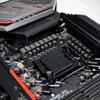Final Words & Conclusion
Conclusion
The Asrock Z590 PG Velocita certainly is an interesting product. It looks really well. For RGB lovers, there are two addressable and two regular LED strip headers, and one CPU cooler LED strip header, with nice access to eight 4-pin headers overall. The DDR4 slots support up to 128 GB of RAM and handle up to DDR4-4800 memory (with 11th gen processors; with 10th Gen, it’s 4666 MHz), which is a really good result. The Asrock Z590 PG Velocita has only a single main PCIe 4.0 x16 slot supported by the processor, and there is an extra PCIe 3.0 x4 slot provided by the chipset. The audio for this board does look nice, with the Realtek ALC1220 codec paired Nahimic. The M.2 slots support one PCIe 4.0 x4 drive and two PCIe 3.0 x2 drives. The price of the Asrock Z590 PG Velocita is about 299 USD, which makes it rather expensive. You might want to know that this board has robust, 12+2 power delivery.
DDR4 Memory
Memory compatibility should not, and likely will not be an issue as long as you stick to recently released DIMMs. There are many really good Intel-optimized kits out there (more than for the Ryzen CPUs). Also - go for at least 16 GB in dual channel, with a frequency of 3200 MHz (CL14/CL16) or 3600 MHz (CL16/CL18).
Power consumption
The Intel Core i9 10850K doesn’t really shine in the power consumption department. It’s a 125 Watt TDP processor. With the system at idle with a GeForce RTX 2080 Ti installed / 32 GB memory / SSD and the Z590 motherboard, I hovered at roughly 70 Watts in IDLE. The Z590 doesn’t really bring any benefit for it (and why would it?), so when we stressed the processor, we reached 300 Watts of power consumption (but you need to remember it's for the whole system, not the CPU alone). We used a 10-core CPU with this Z590 board, which is the max number of cores available for socket 1200 (even considering the Rocket Lake).
Performance & tweaking
The 10 cores like a bit of extra voltage if you’re looking to do some tweaking. To get to 5.1~5.2 GHz on all cores, you will probably need at least 1.35, or rather closer to 1.4-1.45 V on the processor. This makes power consumption grow rather rapidly. If you plan a tweak at that 5.2 GHz mark, then you will need LCS. The process of OC that Z590 offers is easy to use: you increase the CPU voltage and multiplier and that’s it. Another plus for the Intel platform is that over the years they have been able to refine their memory controllers. Pop in anything XMP 2.0 and you have more than a 90% chance it'll work straight out of the box with very fast memory.
Final words
The ASRock Z590 PG Velocita is a proper model in that Z590 Phantom Gaming family. With an integrated I/O shield, solid RGB implementation, PCIe 4.0 compatibility with future CPU generations (both for the GPU and the NVMe drives), the ASRock Z590 PG Velocita really has the speed (Velocita) it claims. It looks good, has a solid feature set, and performs well. The Z590 PG Velocita would handle even the 8-core Intel Core i9 11900K with ease. The price is about 299 USD, so a lot for what is still essentially a mainstream to high-end chipset, but you get two ethernet solutions (one of them is 2.5 Gbit), an 802.11ax Wi-Fi 6E Module, 14-phase power, nice audio quality, as well as 3x NVMe ports and 6 SATA ports. Additionally, you get Asrock’s GPU Holder solution, which should help prevent the graphics card from sagging. RGB lovers can enjoy two regular and two addressable RGB headers for the bling. The Asrock Z590 PG Velocita surely deserves the Recommended award for all that it delivers, but you need to remember the price tag as well as the fact that the competition is very strong. Other than that, and the price, we got no other major complaints. Well, maybe there is something. No Thunderbolt port on I/O can be missed by some of you. In the end, ASRock’s Velocita is a solid mid-range option for your 10th (or better 11th) generation Intel system. It does what it's supposed to, period.
Handy related downloads:
- Sign up to receive a notification when we publish a new article
- Or go back to Guru3D's front page



